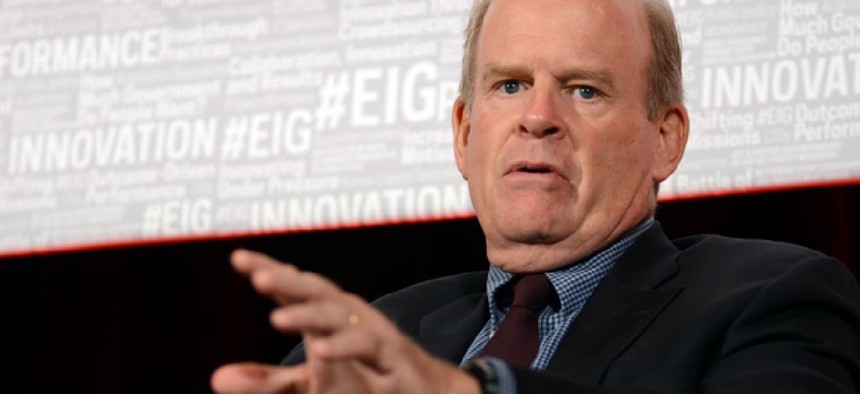'Energy and excitement' make presidential transitions ripe for innovation
Expertise of career feds is key to collaboration and success, panelists say.
The chaos and quick decision-making needed when the government goes through a post-election transition is a “natural time” for creativity and innovation, veterans of recent changeovers told a conference of federal employees on Thursday.
Political appointees, they agreed, are “totally dependent” on the expertise of career civil servants to keep the government functioning during such periods of vulnerability.
Speaking at the Excellence in Government conference sponsored by Government Executive Media Group under the theme “Delivering on Mission: Leading Through the Complexity of Transition,” Clay Johnson III, deputy director of the Office of Management and Budget under President George W. Bush, recalled how during the transition in 2000 his colleagues “worked faster than warp speed amid the many distractions, with all the agency career people feeling discombobulated.”
Briefings from outgoing officials and filling positions must be done while maintaining “competencies in national security because the bad guys may mess with us during this vulnerable time,” Johnson said. His approach was to set seven or eight clear goals for what must be accomplished in the first few months, giving the agencies performance objectives and “focusing on what might keep you from accomplishing those goals.”
Lisa Brown, acting chief performance officer at the Obama administration’s OMB who was on the receiving end of Johnson’s transition briefings in 2008, agreed “there’s so much going on in government on the table, you have to keep the momentum going and make sure what you need is at the top of the pile, whether it involves legislation, regulations, litigation or budgets. It’s tempting to do absolutely everything.”
The spirit during a transition is one of “we’re all on the same team,” despite having just fought a political campaign, Brown said. “No one is hiding the ball. They pass on information whether it involves keeping or changing a policy. They all know these are serious issues” and want to do things right. “There’s so much energy and excitement, it’s a natural time to innovate.”
Coast Guard Rear Adm. John Acton, executive director of leader development at the Homeland Security Department, noted that 2008 was DHS’ first transition. The “bad news was we had nothing to build on, no template,” he said. But that was also the good news “because the situation gave us room to maneuver.”
He found value in the “air cover from top leaders” -- departing Homeland Security Secretary Michael Chertoff and Deputy Paul Schneider -- and said the Obama review team that came in was “not who you’d encounter on a campaign but seasoned professionals who hit the ground running.”
The 24-7 work of a transition “can be a meat grinder,” he said, recalling responding to requests at 2:00 a.m. The main challenges included identifying potential career people (and a backup) to fill vacancies and to provide “tailored training for people who must serve in acting roles that are broader than their day-to-day job.”
Panel moderator Pat McGinnis, former president of the Council of Excellence in Government, noted that the 75 days between Election Day and the inauguration, depending on who wins, is either a major transition or a “mini-transition, which can still be an opportunity to push the reset button and make leadership changes.” It can take up to a year to get the sub-Cabinet members in place, she said, adding this year will involve added complexity because of unresolved budget issues, the so-called fiscal cliff. It’s not enough, she said, to “just do a good or smooth transition. We must focus on changes that move the ball forward, where should we be in two years, what will it take?”
All agreed large briefing books are seldom read but often consulted, and some officials need only a 50-page collections of short memos rather than 1,200-page binders.
“Some executives find it difficult to be candid while laying out the issues since it’s natural to want to put your best foot forward,” noted Acton, who “stays agnostic” politically. He recommended that briefers use a “deliberate, mature process that speaks truth to power.” Rather than saying, “we already tried that,” it’s better to “lay out options and help the new team think through the agenda,” he said. Career employees “must juggle a key role in the transition with staying focused on their agency’s critical mission” while seeking to “set up an environment that is transparent and collaborative for success.”
Johnson added he avoided asking agency staff which of their offices are good or bad, but focused on the actions that had to be taken in the next 30 days. “It’s not all Kumbaya -- we focus on risks and opportunities and ask what’s working against us,” he said. “The killer question is, ‘What’s the picture of success?’ ” He recommended beginning every meeting by asking, ‘What do we want to accomplish?’ ”
Brown said, “career people have a huge amount of knowledge, and you want that information, so recognize them and be respectful of it.”
NEXT STORY: Innovation Isn't Always Big




